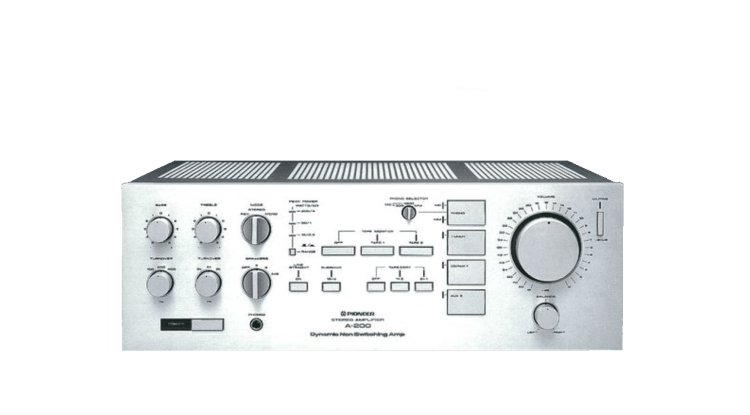Vintage: Pioneer A-200 - 1982 release

The Integrated Amplifier was created with the goal of improving the amplifier's quality and dynamic range.
The dynamic power supply scheme and non-switching circuit were used, and high power with quality in an overall matching the notion of true dynamism was obtained.
The dynamic power supply scheme has been used as a power-source portion because it relates to the wide dynamic-range-ization of the source and the speaker has been fully sounded likewise with the time of the Dainyuu power.
This scheme's power circuit consists of two power supply sections, a low-voltage portion (VL) and a high-voltage part (VH), with the low-voltage part typically driving only with signal level and the high-voltage part driving at the time of better and the Dainyuu power.
As a result, a loss of an output stage decreases sharply and high power is possible.
Furthermore, because a high-voltage portion receives a signal waveform and always responds with a constant voltage value, it does not create a wave-like deficit.
Because it is the design of locking as long as a signal persists while the high-voltage section is locked when the Taishin number repeats in a wide area, the wave-like deficit caused by being late has been avoided.
And the transformer had little magnetic flux leakage, and the large-sized toroidal transformer with a high regulation was used, and the electrolytic capacitor was put into operation carrying eight and having a total capacity of 176,000 micro F, etc., and it has achieved low-impedance-ization.
Nonmagnetic-ization, such as employing copper lead wire and an oxygen-free-high-conductivity-copper line for a power-source portion, was implemented, and a detrimental magnetic distortion was eliminated.
The non-switching circuit with a well-known repute that realized switching distorted zero in a power portion is used.
A bias current is regulated according to an input signal by Pioneer's original high-speed bias servo circuitry, and this is pushing down the dirt of the music by switching distortion essentially by the method that always maintains a transistor at a functioning state.
The FET buffer circuitry was used between the voltage amplification and power amplification parts, the voltage amplification and power amplification parts were totally separated, and the nakedness property before using NFB was greatly improved.
Even if a FET's input impedance is infinitely close and the property top power amplification part receives a load-impedance variation because it does not appear in the influence's input side, the operation of a voltage amplification part is stabilized, and it can drive by a low-power-output impedance in a power amplification part.
The MC head amplifier analyzes a push-pull stream composition from an input to an output, and it also makes the input a parallel push-pull by using a super-low-noise FET. The feeding back point of a DC servo is moved to the second step of the bias power-source section rather than the first rank, and servo circuitry has no effect on an SN ratio is taken into account.
As a result, the SN ratio was adjusted to 74dB, and the amazing property that it presses only in the 76dB grasp, which is the theoretical threshold value by thermal noise, such as a transistor in this circuit system, was realized.
As an MC head amplifier, an equalizer amplifier, and a power amplifier, DC servo circuitry is used.
This removes all coupling capacitors from the MC input to the speaker output, achieving whole-page non-coupling-capacitor-ization and achieving high-resolution tone quality while reducing concern about the coloration of the sound caused by a capacitor, etc.
The line straight switchpoint is carried, which directly connects an equalizer amplifier and a power amplifier and yields a tone quality with great purity.
A tone control, mode, and balance volume are all passed, and a signal path is simplified.
The nonmagnetic component is used to minimize magnetic distortion, which has a negative impact on tone quality and to achieve a greater purity tone quality.
Copper lead wire is utilized as the semiconductor for each amplification step, and copper is also used for the lead line cap of key resistors, such as an emitter resistor.
Furthermore, copper is used for main capacitor lead wires, and the oxygen-free-high-conductivity-copper line is used for the main product-line material.
The chassis was copper-plated, and the resonance of a frame is prevented as an H-type structure.
Cross-interference is avoided by intercepting power amplifier Lch separations, Rch independence, the Taishin number system, a small signal system, equalizer amplifiers, and all MC head amplifiers on a structure.
As a power cord, a very-thick power cord with a double insulation construction is used.
| Form | Integrated Amplifier |
| Effective output | 200W+200W (20Hz - 20kHz, both channel drive, 8ohm) |
| THD (20Hz - 20kHz) | 0.002% (at the time of an effective output) |
| Cross modulation distortion (50Hz:7kHz=4:1) | 0.002% (at the time of an effective output) |
| Output bandwidth | 5Hz - 65kHz (IHF, both channel drive, THD0.01%) |
| Output-terminal | Speaker(4ohm-16ohm): A, B, A+B Tape Rec:150mV |
| Dumping factor | 140 (20Hz - 20kHz, 8ohm) |
| Input sensitivity/impedance | Phono man month: 2.5mV / 50kohm Phono MC: 0.15mV/100ohm, 33ohm, 8ohm Tuner, AUX, Tape Play1, 2:150mV / 50kohm |
| Phono maximum permissible input (1kHz, THD0.0008%) | MM:300mV MC:18mV |
| Frequency characteristic | Phono man month: 20Hz-100kHz}0.2dB Tuner, AUX, and Tape Play:1Hz-200kHz+0 -3 dB |
| SN ratio (IHF, A network, a short circuit) | Phono MM:90dB Phono MC:74dB Tuner, AUX, Tape Play: 115dB |
| Tone control | Bass: }6dB (100Hz) Treble: }6dB (10kHz) |
| Filter | Low: 15Hz, 6 dB/oct. |
| Supply voltage | AC100V, 50Hz/60Hz |
| Power consumption (Electrical Appliance and Material Control Law) | 360W |
| Dimensions | Width 420x height 150x depth of 420mm |
| Weight | 19.0kg |





































